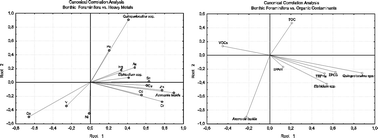We propose a detailed investigation on the distribution patterns of the benthic foraminiferal assemblage and their predominant species in the highly contaminated marine sediments of the Naples harbour. Combined use of multivariate canonical, cluster and principal component analysis in a proper geostatistic framework provided an appropriate approach to explore the role played by a number of contaminants (heavy metals, polycyclic aromatic hydrocarbons, volatile organic compounds, heavy hydrocarbons, PCBs) and different physical parameters (grain size, pH, redox potential, total organic carbon) on the spatial distribution of the benthic foraminiferal assemblage and its single species. Obtained results provide evidence for a high and systematic non-linear response of the biota to the effects of contamination of the different classes of pollutants. The reduced number of specimens per sample, their small dimensions and low diversity, testify the negative effects of a highly contaminated environment. For this reason, it appears very difficult to clearly identify a differential sensitivity of different benthic species to single classes of contaminants. In particular, in addition to a number of case studies which invoked a key role of the heavy metals in the control of the distribution patterns of the benthic foraminifera in the marine environment, the results presented here underline an important effect of some classes of organic compounds (particularly the volatile organic compounds) on the distribution patterns of the benthic assemblage. However, the obtained results demonstrate that any kind of oversimplification would unquestionably cancel the strong complexity of the biotic response to combined effects of different coexisting contaminants.

You have access to this article
 Please wait while we load your content...
Something went wrong. Try again?
Please wait while we load your content...
Something went wrong. Try again?


 Please wait while we load your content...
Please wait while we load your content...